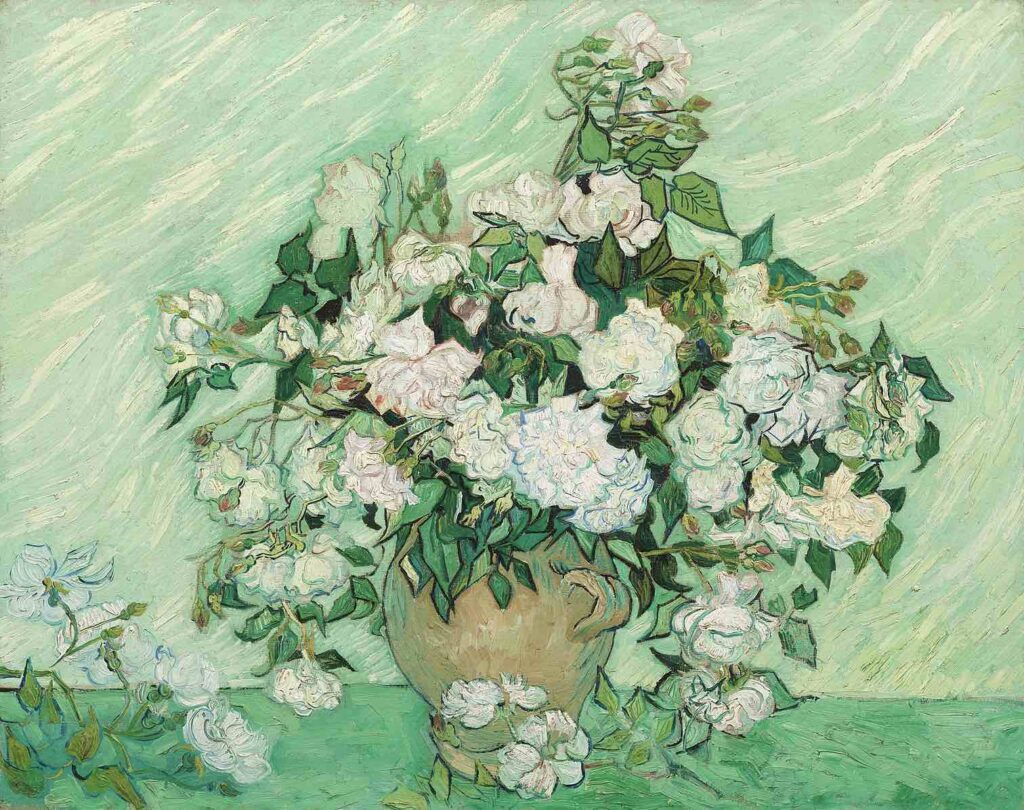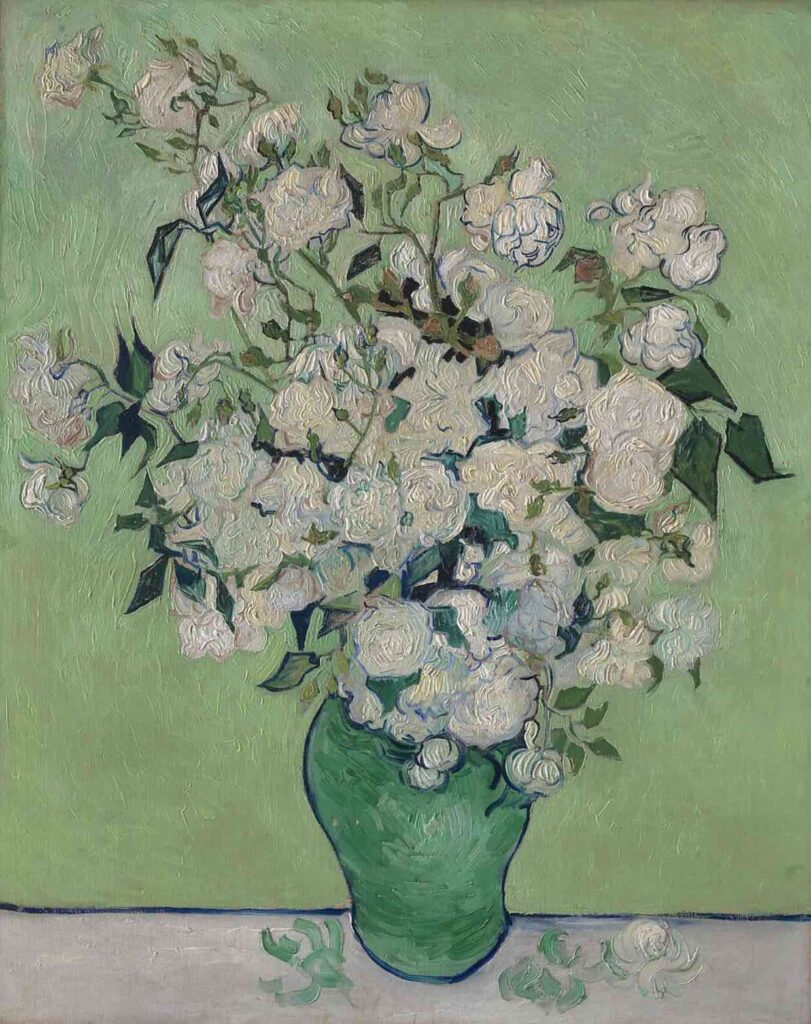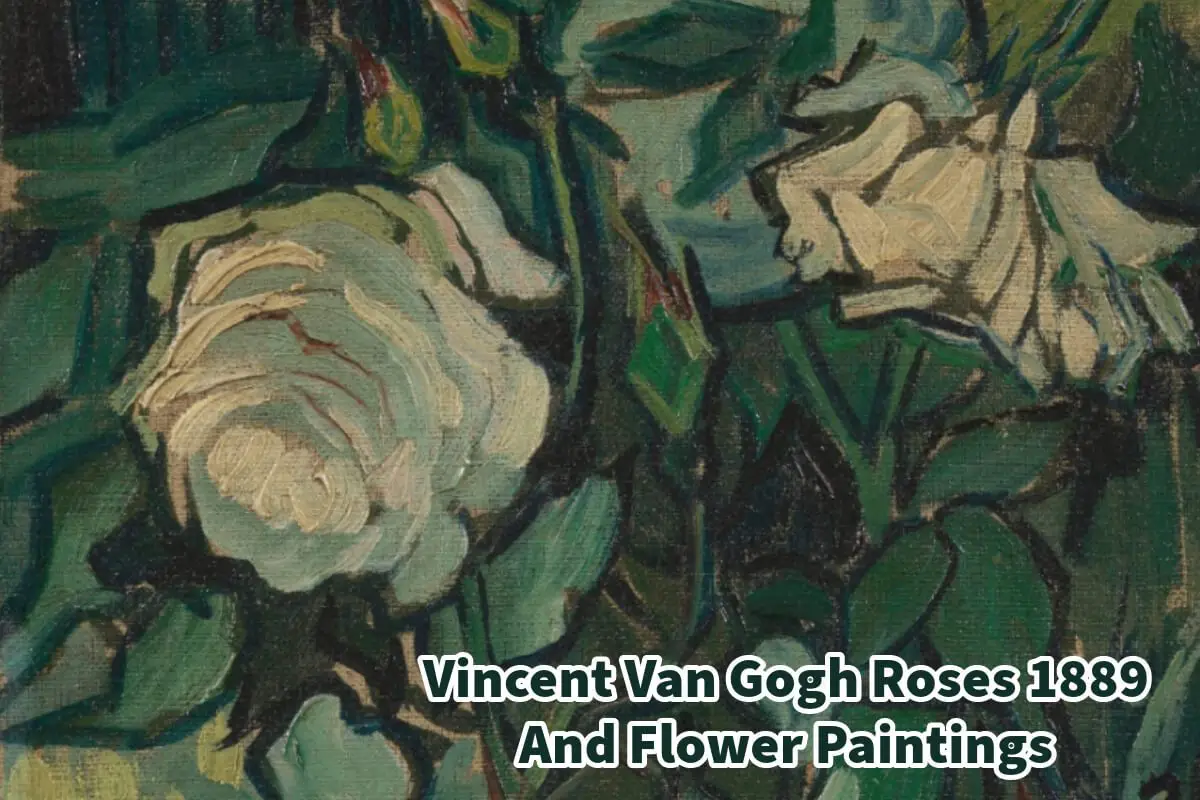Vincent Van Gogh is one of the most influential artists who ever lived. He is undoubtedly one of the most celebrated artists in history.
Vincent Van Gogh had a profound affinity for painting flowers, and one of his notable works in this genre is titled “Roses.” Join us as we delve into the enchanting world of his “Roses” painting and uncover the eight compelling reasons that fueled his passion for painting flowers.
Table of Contents
- Vincent Van Gogh’s “Roses” (1889): A Blossom Of Artistic Intrigue
- Vincent Van Gogh A Meticulous Observer Of Nature
- The Journey Of “Roses” Explored
- 8 Reasons Why Vincent Van Gogh Loved Painting Flowers
- Frequently Asked Questions
- Related Questions
Vincent Van Gogh’s “Roses” (1889): A Blossom Of Artistic Intrigue
In art, Vincent Van Gogh stands as an iconic figure known for his mastery of color, profound emotional depth, and an unparalleled ability to capture the beauty of the natural world.

Among his extensive work, “Roses” (1889) emerges as a captivating masterpiece that invites us into the mesmerizing world of delicate blooms. We will delve into the enchanting painting of “Roses,” shedding light on why this particular work is essential in Van Gogh’s oeuvre.
The Ever-Changing Hue Of Roses
“Roses” is a remarkable painting that draws our attention to the exquisite beauty of the flowers and a fascinating detail: the color transformation of the roses over time.
Initially, these roses were a vibrant shade of pink, imbuing the painting with a lively and energetic aura. However, as time passed, the pigment used in the paint gradually bleached, leaving behind hints of the original pink hue.
This subtle metamorphosis tells a story of the passage of time and the evolving nature of art itself.
Vincent Van Gogh A Meticulous Observer Of Nature
One cannot help but notice the meticulous precision with which Van Gogh depicted a tiny yet significant detail within the painting—an insect resting on a leaf at the bottom of the composition.
This insect is none other than the rose chafer beetle (Cetonia aurata), distinguished by its striking white stripes on its underbelly and the tiny barbs on its legs. Van Gogh’s attention to this detail goes beyond mere artistic flair; it reflects his deep fascination with the intricacies of the natural world.
It is believed that Van Gogh had previously sketched this beetle and, when creating “Roses,” likely traced over his initial sketch. This level of precision showcases his dedication to capturing the essence of nature and adds a layer of scientific curiosity to his art.
Van Gogh was an artist and a keen observer, and “Roses” exemplifies his commitment to authenticity in his work.
The Journey Of “Roses” Explored
The journey of “Roses” through time and ownership is equally intriguing. After its creation in 1889, the painting was in the possession of Van Gogh’s brother, Theo Van Gogh, in Paris.
Following Theo’s untimely death on January 25, 1891, “Roses” became part of his widow Jo van Gogh-Bonger’s inheritance, along with their son, Vincent Willem van Gogh.
Jo van Gogh-Bonger was crucial in preserving Van Gogh’s legacy, ensuring his art reached wider audiences. The painting remained within the family until July 10, 1962, when it was transferred to the Vincent van Gogh Foundation in Amsterdam.
A significant agreement was reached between the Foundation and the State of the Netherlands, entrusting the collection’s preservation and management, as well as the establishment of the Rijksmuseum Vincent van Gogh in Amsterdam, to the State.
“Roses” was generously lent to the Stedelijk Museum in Amsterdam until the opening of the Rijksmuseum Vincent van Gogh on June 2, 1973. Since July 1, 1994, it has found its permanent home at the Van Gogh Museum in Amsterdam, allowing art enthusiasts and admirers of Van Gogh’s work to experience the painting’s enchanting beauty up close.
Roses” (1889) by Vincent Van Gogh is more than just a painting of delicate flowers; it encapsulates the essence of time, the artist’s unwavering fascination with nature’s intricacies, and the enduring legacy of one of the greatest artists in history.
Its journey from vibrant pink to delicate hints of color mirrors the evolution of art and the passing of days.
As we gaze upon “Roses,” we are reminded of the artist’s enduring commitment to authenticity and his ability to capture the fleeting beauty of the world around us. This painting serves as a testament to the profound impact of Vincent Van Gogh’s art on the world and our hearts.
8 Reasons Why Vincent Van Gogh Loved Painting Flowers
Vincent van Gogh’s profound love for painting flowers was deeply rooted in his artistic vision and personal connection to nature. Several compelling reasons can be attributed to his passion for capturing the beauty of blooms on canvas:

Expression Of Emotion:
Van Gogh’s art was a means of expressing his innermost emotions and feelings. Flowers provided a versatile and vibrant subject matter that allowed him to convey various emotions, from joy and vitality to melancholy and introspection.
Each brushstroke and color choice in his floral paintings served as a conduit for his emotional depth.
Study Of Color:
Van Gogh was a pioneer in the use of color in art. His fascination with color theory and its emotional impact led him to explore the intricate color palettes of various flowers. He believed color could convey mood and energy, and flowers offered him the perfect canvas to experiment with his theories.
Connection To Nature:
Throughout his tumultuous life, Van Gogh sought solace and inspiration in the natural world. He viewed flowers as a direct connection to nature’s beauty and found peace in observing their growth and transformation. Painting flowers allowed him to bring the serenity of the natural world into his turbulent life.
Symbolism And Meaning:
Flowers are rich in symbolism and meaning. Van Gogh often infused his floral paintings with more profound significance. For example, sunflowers represented adoration and loyalty, while irises symbolized hope and communication. By incorporating these symbols into his art, he added complexity and depth to his work.
Accessibility:
Flowers were readily available to Van Gogh, even during financial hardship. Unlike hiring models or traveling to specific locations, he could find inspiration in the simple yet exquisite flowers that grew in his immediate surroundings.
This accessibility allowed him to create prolifically and consistently.

Joy In Simplicity:
Van Gogh had a deep appreciation for the beauty in everyday life. He found joy in the simplicity of flowers and believed that even the most common blossoms held extraordinary charm. Through his paintings, he shared his ability to see the extraordinary in the ordinary.
Legacy And Immortality:
Van Gogh envisioned creating art that would outlive him and resonate with future generations. His flower paintings were a testament to his love for nature and a way to leave a lasting legacy.
He hoped his art would continue inspiring and bringing people joy long after his passing.
Healing And Therapy:
During periods of mental distress and emotional turmoil, Van Gogh turned to art as a form of therapy. Painting flowers, with their calming and harmonious presence, gave him a sense of healing and serenity. It allowed him to escape the turmoil within momentarily.
Vincent van Gogh’s love for painting flowers was an artistic pursuit and a profound reflection of his complex and passionate personality. Through his vibrant floral compositions, he managed to convey the essence of life, emotion, and the enduring beauty of the natural world, leaving an indelible mark on the world of art.
Anita Louise Art is dedicated to art education, great artists, and inspiring others to find and create their art. We love art that uplifts and inspires. #ArtToMakeYouSmile! #ArtToMakeYouHappy!
If you want to see any of my art, you can find out more by clicking here. If you are interested in what inspires me and my paintings, you can discover more by clicking here.
We have a free newsletter and would love you to be part of our community; you can subscribe to the newsletter by clicking here. If you have any questions, I would be happy to talk to you anytime. You can reach me, Anita, by clicking here.
Subscribe to our Anita Louise Art YouTube Channel with great videos and information by clicking here.
Join us for our podcast “5 Minutes With Art.” Spend just 5 minutes a week with us to discover and learn about great art and artists. You can find out more about our podcast by clicking here.
Frequently Asked Questions
What inspired Vincent Van Gogh to paint flowers, particularly the “Roses” in 1889?
Van Gogh was captivated by the beauty of nature and found solace in depicting it on canvas. His inspiration often stemmed from his surroundings, and flowers, with their vibrant colors and intricate details, became a recurring subject in his art.
Why did Vincent Van Gogh choose roses as the focal point of this painting?
Roses, with their symbolic significance and diverse varieties, held a special place in Van Gogh’s heart. He saw them not only as aesthetically pleasing but also as carriers of deeper meanings, reflecting emotions, life, and the fleeting nature of beauty.
How did Van Gogh’s use of color contribute to the impact of his flower paintings, including “Roses”?
Van Gogh’s mastery of color was pivotal in creating emotional resonance in his paintings. In “Roses,” he employed bold and expressive hues to convey the intensity of his feelings, making the flowers come alive on the canvas.
Were flowers a recurring theme in Vincent Van Gogh’s body of work?
Yes, flowers were a recurrent motif in Van Gogh’s oeuvre. He painted various types of flowers throughout his career, exploring the symbolic and emotional depth they offered. Sunflowers, irises, and almond blossoms are among the other flowers he depicted in his art.
What techniques did Van Gogh use to capture the texture and essence of the roses in the painting?
Van Gogh applied thick, impasto brushstrokes to create a textured surface that enhanced the visual and tactile experience of the roses. This technique allowed him to convey not only the appearance but also the essence of the flowers.
Did Vincent Van Gogh have a personal connection to the roses he painted, or was it purely artistic inspiration?
While Van Gogh had a genuine love for nature and its beauty, his choice of subjects often carried personal significance. Roses, in particular, might have held symbolic meaning for him, representing themes like love, passion, and the fleeting nature of life.
How did Van Gogh’s mental state influence his approach to painting flowers, including the “Roses” artwork?
Van Gogh’s mental struggles undoubtedly influenced his artistic style. During periods of emotional turbulence, his paintings often became more expressive and vibrant. The emotional intensity in his flower paintings, including “Roses,” can be seen as a reflection of his inner turmoil.
Are there hidden meanings or symbolism in Vincent Van Gogh’s “Roses” painting?
Van Gogh often infused his work with symbolic meaning. In “Roses,” the choice of roses and their arrangement may carry symbolic significance, possibly representing themes such as love, beauty, or the transience of life. Interpretations can vary, adding layers to the painting’s depth.
Related Questions
Did Michelangelo And Leonardo Know Each Other?
Michelangelo and Leonardo da Vinci knew each other but were considered bitter rivals. Leonardo da Vinci and Michelangelo knew each other, but they did like each other. They were both asked to do a commission on the Council Hall of the Palazzo Vecchio and were supposed to work side-by-side; the project was never completed.
By clicking here, you can learn more by reading Did Michelangelo And Leonardo Know Each Other?.
What Was The Focus Of Renaissance Art?
The focus of Renaissance art was on the classics of Greek and Rome, humanist philosophy, and the study of the human figure. Realism was also an essential part of renaissance art. The great artists of the Renaissance also became great anatomists and studied human beings.
By clicking here, you can learn more by reading What Was The Focus Of Renaissance Art?.
Michelangelo’s Method To Paint The Sistine Chapel Ceiling
He built a large scaffolding structure that could move around the chapel to paint the ceiling; the painting of the Sistine Chapel was an extremely strenuous work that was a huge personal cost both physically and mentally to Michelangelo.
By clicking here, you can learn more by reading Michelangelo’s Method To Paint The Sistine Chapel Ceiling.


